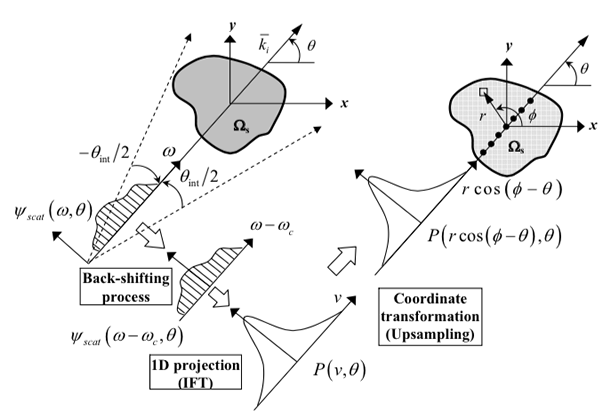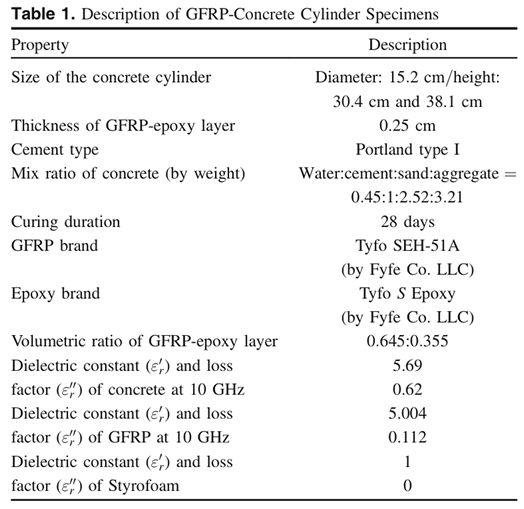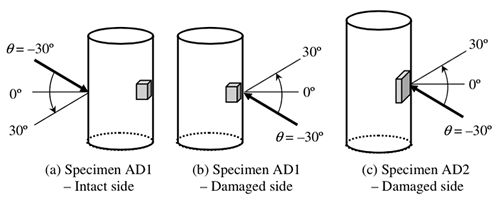SERG -- Topics
Synthetic Aperture Radar (SAR) Imaging of Concrete Specimens and Structures
Tzuyang Yu, Associate Professor, Ph.D.
Principle
SAR imaging is a technique to develop surface and subsurface images of dielectrics (e.g., Portland cement concrete) for condition assessment in remote sensing. The concept is to utilize the backprojection of frequency modulated radar signals (electromagnetic waves) into the space domain (range vs. cross-range) to illustrate the intensity distribution of scattered radar signals. Fig. 1 shows the process of backprojection operation.

Fig. 1. Process of the backprojection algorithm [Yu 2011]
In this radar imaging process, one key parameter is the inspection mode. In theory, the radar travels with respect to a target on a predetermined path (aperture). Different paths indicate various inspection/imaging modes, such as stripmap, spotlight, and inverse. Fig. 2 shows the concept of synthetic aperture, using inverse SAR (ISAR) as an example.

Fig. 2. Concept of synthetic aperture [Yu 2011]
In practice, inspeciton mode suggests the way a radar sensor triggers the scattering signal represnting the presence of a target (e.g., defect, steel rebar). Considering a GFRP (glass fiber reinforced polymer) wrapped concretre specimen in the inspeciton mode, two possible inspection modes can be used, as shown in Fig. 3.
Application
Subsurface Delamination Detection
Two GFRP-concrete spceimens (Fig. 4) are applied for radar imaging. Material properties of these specimens are listed in Table 1. These specimens are inspected by a widebandwidth imaging radar (8~12 GHz) in three different scenarios in order to develop intact and damaged radar images of these specimens (Fig. 5).

Fig. 4. Two artificially-damaged GFRP-concrete specimens


Fig. 5. Inspection scenarios of artificially-damaged GFRP-concrete specimens
Radar images of both the intact and damaged sides of AD1 and the damaged side of AD2 are provided in Figs. 6 and 7. Inspection angle in all these images was 15 degrees.
Fig. 6. Radar images of the intact (left) and damaged (right) sides of the specimen AD1
Fig. 7. Radar images of the damaged side of the specimen AD2 in two polarizations; (left) HH (right) VV
Findings
- The processing of far-field radar measurements by using the back-projection algorithm shows promising results by suc- cessfully discovering the presence of an artificial defect in reconstructed radar images. However, assertion on their presence should be made based on the images at several incident angles.
- Effectiveness of incident angle on damage assessment is affected by the measurement scheme. In the specular recessive scheme shown in Fig. 6(b), background signals dominate the total response, making defect signals undetectable. Relevant inspection scheme must be chosen to alleviate the impact of background signals in the method.
References
- Yu, T., T.K. Cheng, A. Zhou, D. Lau, Remote defect detection of FRP-bonded concrete system using acoustic-laser and imaging radar techniques, Construction and Building Materials 2016; (109): 146-155. (pdf)
- Yu, T. A distant damage assessment method for multi-layer composite systems using electromagnetic waves, Journal of Engineering Mechanics, ASCE 2011; 137 (8): 547-560; doi:10.1016/j.conbuildmat.2007.09.009 (pdf)
- Yu, T., O. Buyukozturk. A far-field airborne radar NDT technique for detecting debonding in GFRP-retrofitted concrete structures. NDT&E International 2008; 41: 10-24; doi:10.1016/j.ndteint.2007.07.002 (pdf)
